Preservation
of a Healthy Black Bear Population in the Sierra Nevada Mountain Range through
Interagency Cooperation
Tori Seher Yosemite National Park, P.O. Box 577, Yosemite, CA 95389
Rachel Mazur Sequoia and Kings Canyon National Parks, 47050 Generals Highway,
Three Rivers,
CA 93271
Calder
Reid Inyo
National Forest, 873 North Main Street, Bishop, CA 93514
Adam Rich Stanislaus National Forest, 1 Pinecrest Lake Road, Pinecrest, CA 95364
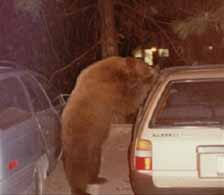 |
| Late night snack in Yosemite: Disregard of
proper food storage regulations lead to the death of "problem" bears. Photo: YCS Security, Fire & Safety |
The Sierra Interagency Black Bear Group (SIBBG) was formed in 2000 to reduce human-bear conflicts. SIBBG members include Sequoia and Kings Canyon National Parks, Yosemite National Park, Inyo National Forest and Stanislaus National Forest.
The Sierra Interagency Black Bear Group has three goals:
As California’s black bear and human populations increase throughout the state, there are increasing numbers of human-bear conflicts. In several National Parks and Forests, these conflicts lead to ruined vacations, human injuries, extensive property damage and, all too often, a dead bear.
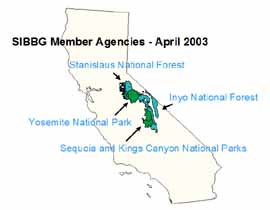 |
| The four Sierra land management agencies that form the Sierra Interagency Black Bear Group. |
Methods
1. Adopt standard protocols for testing and approving bear-resistant
food storage containers.
2. Prior to implementation, coordinate all proposed visitor use restrictions
which have the potential to affect bear biology or management.
3. Where possible, adopt rules, restrictions, and policies across ecological
landscapes rather than administrative boundaries.
4. Develop and manage an interagency
web site where visitors and staff may
conveniently access information about bears and food storage.
5. Share training and cross-training opportunities.
Results to Date:
Testing Methodology and Approval of Bear-resistant Food Storage Containers
In all SIBBG areas, the use of SIBBG APPROVED, bear-resistant
food storage containers is encouraged and, in some areas, required. The SIBBG
approval
ensures that canisters have the basic strength that is needed to resist a
black bear’s attempts to gain entry. Once a bear learns that it cannot
open a container, it will leave campers whose food is properly stored in
canisters alone.
So how does a container become approved?
The SIBBG uses the following tests to approve containers:
Test 1
Visual Inspection and the Drop Test
In order to pass the visual inspection, a container must not have gaps, the
lid must be recessed, and it must be made of materials known to be bear-resistant.
It must not pose a threat of injury to bears, other wildlife or humans;
be inconsistent with wilderness ethics, or result in damage to the natural
environment. In addition, the container cannot serve only as a delay tactic,
or appear excessively complicated or difficult for users to operate. It
must also be able to withstand being dropped.
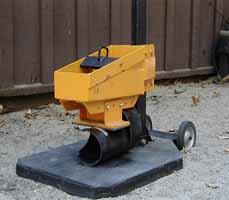 |
| The Crushinator: stronger than a bear and it doesn't drool. Photo: National Park Service |
Test
2
Structural Testing
The structural test is conducted using an approved “impact-testing” machine
developed by the Missoula Technology Development Group. During the test,
100 foot-pounds of energy (a 100 pound cartridge dropped from one foot)
are dropped once on the container lid, and one time on the side. To pass
the structural test, the container must not have any cracks, openings or hinges
that would allow a bear to gain entry by biting or pulling with it’s
claws, in other words, none greater than 1/8 inch.
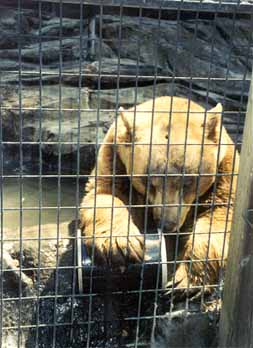 |
| Never underestimate
an animal you can teach to ride a bicycle... . Photo: National Park Service |
Test
3
Animal Testing
Captive black bears in a zoo are used to test containers that have passed
the visual and structural tests. Containers are filled with odorous foods,
weighted to approximate actual use conditions, and presented to one or
more black bears who have had their daily meals withheld on the day of
the test.
Test
4
Field Evaluation
If the container passes the first three tests, it is given conditional approval
and it may be legally used in SIBBG areas. Containers will be field tested
by participating agencies for three months during the first year of conditional
approval. If a container is successful in this field evaluation, the container’s
status will be upgraded to “approved.” It is important to note
that if a canisters fails — even once approved — it will lose its approval.
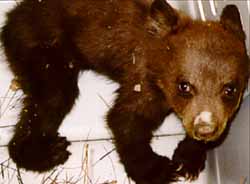 |
| One of
three cubs that was sent to a rehabilitation center in 2000 and then
successfully reintroduced into the parks in 2001. Photo: Amber Bethe |
Implementation
1. The first Testing Methodology and Approval of Food Storage Containers
for Use in Yosemite, Sequoia and Kings Canyon National Parks, and Inyo National
Forest was implemented in April, 2001.
2. In 2000, when both Yosemite National Park and Sequoia and Kings Canyon
National Parks were faced with motherless spring cubs, they coordinated efforts
and sent all three cubs to a rehabilitation center together. All three cubs
were successfully reintroduced in 2002.
3. As a result of better interagency cooperation, food storage restrictions
now cover ecological areas, even if that means crossing agency, political
or other management boundaries.
4. In 2001, the SIBBG created an interagency web site that may be found at
www.sierrawildbear.gov.
5. All SIBBG agencies have benefited from sharing training, skills, and
expertise.
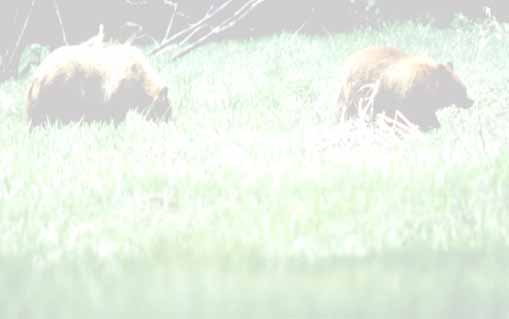 |
| With increasing
use of bear canisters and proper food storage, the sight of bears
foraging for natural foods is becoming much more common in the Sierra. Photo: Raleigh Patterson |
 |
 |
Conclusion
The Sierra Nevada is home to roughly forty percent of the black bear population
in California; tens of thousands of people who also live there; and hundreds
of thousands of seasonal visitors. The area, which is mostly comprised of
public lands,
is
administered
by eight
National
Forests
and two National Parks. The only way that we will be successful in preserving
a healthy black bear population is to work together.
Acknowledgements
The SIBBG is grateful to our cooperating associations, co-workers, and to
the public for their interest and support in conserving Sierra black bears.
Further
Reading
Sierra
Interagency Black Bear Group (SIBBG) website.
Yosemite National Park: Black Bears
Living With California
Black Bears
Field
Guide description of Black Bears from the San Diego Natural History
Museum
Careless
Californians Attracting Voracious Black Bears — Growing numbers
moving to Central, Southern regions
Our Founder Questions? Go to About Our New Site |
Masthead
Photo from: |